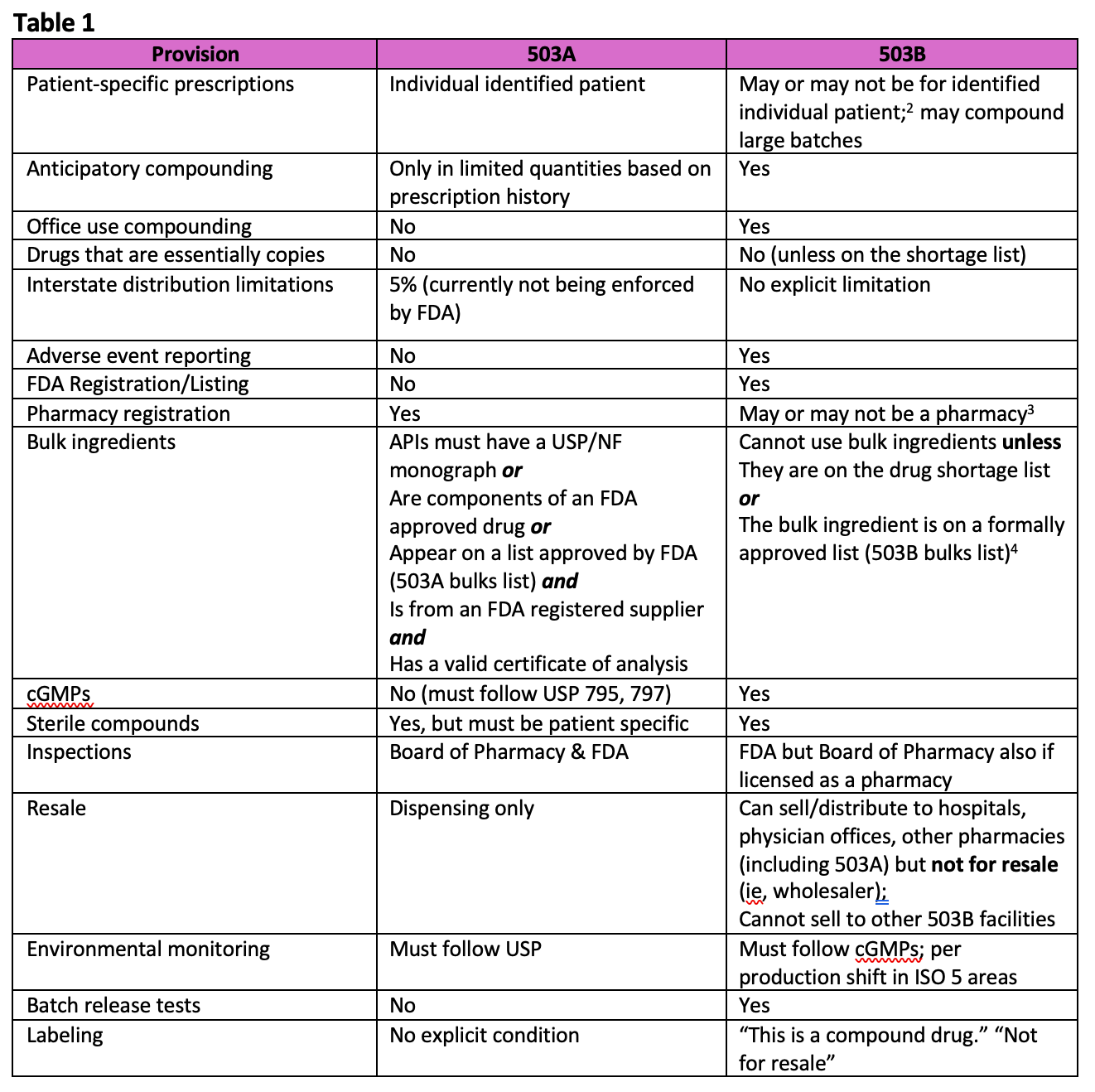News
Article
Regulatory Considerations Regarding the 503B to 503A Compounding Model For Community Pharmacies
A review of the requirements for pharmacies considering ordering compounds from a 503B facility.
On June 27, 2023, the FDA issued a draft guidance permitting 503A pharmacies to purchase compounded medications from 503B facilities for dispensing to patients.1 The guidance stipulates that the compounded medication cannot be altered in any way by the 503A, repackaged (other than placing the pharmacy label on it), broken or split into different dosages, wholesaled by the pharmacy, or transferred to another pharmacy or physician’s office, even for dispensing to an individual patient.
Previously, a 503B facility could distribute non-patient specific compounds prepared to institutional pharmacies such as hospitals as well as other health care institutions and for ‘office use’ for physicians. Some hospitals use multiple 503Bs throughout the country to source different sterile products. 503B facilities may not engage in wholesale distribution of the compounds produced, meaning they cannot sell to buyers who will resell. This does not preclude sales to hospitals, inpatient and outpatient hospital pharmacies, clinics, retail pharmacies, long term care facilities, physician offices, or other entities which dispense or administer the compounds. Per the guidance issued on June 27, 2023, 503B facilities may sell compounds to group purchasing organizations, third-party logistics, and brokers without engaging in wholesaling. Some of the major differences between 503B and 503A compounding pursuant to the Food Drug & Cosmetic Act and various interpretative FDA guidance’s are highlighted in Table 1.2

In the 503B to 503A model, compounds are distributed from 503B facilities to 503A pharmacies for dispensing pursuant to prescriptions at the community pharmacy level are relatively new; it has become pertinent to stay ahead of any developments. Below, we identify a checklist for pharmacies to follow when purchasing from a 503B outsourcing facility.
A. Licenses/Registrations
Although a 503A pharmacy may outsource from a 503B, there may be specific prohibitions or restrictions by a particular state Board of Pharmacy. If dispensing to out-of-state patients, the pharmacy must hold out-of-state licenses in the states where it plans to dispense compounded prescriptions. This step cannot be bypassed because the 503B is the source of the compounded medications.
The outsourcing facility must be registered with the state Boards of Pharmacy or other entity responsible for 503B licensing on a state level for each state it is shipping compounded drugs to. For example, if the 503B is selling to a 503A located in New Jersey (NJ), it must adhere to all NJ rules pertaining to 503B facilities.
Further to logistics and processes involved, only a 503B licensed as a pharmacy can actually dispense patient-specific prescriptions. However, in the 503B to 503A model, the order from the pharmacy is an order for ‘office stock’ for dispensing. The pharmacy does not submit the individual patient prescriptions to the 503B.
B. Dispensing
The 503A can only dispense the 503B compounded prescription to a patient or the patient’s agent (except for controlled substances as a physician cannot be the patient’s agent for these medications). Deliveries from 503A compounders of prescriptions dispensed to patients using 503B compounds to providers (eg, physicians, nurse practitioners) for administration to the patient is permitted. However, the prescription must be a patient-specific prescription and not for office use. That is, the prescription is actually dispensed to the patient and labeled as such but delivered to the prescriber’s office for administration on site. The practitioner cannot then redispense the prescription drug to the patient. This is prohibited under 503A rules and explicitly prohibited in certain states, such as in NJ.
C. Liability Mitigation
There is shared liability between the pharmacy purchaser/dispenser and the 503B outsourcing facility, which further underscores that a thorough vetting process is of the utmost importance when selecting a 503B outsourcing partner. Establishing a contract between the 503A and 503B addressing adverse events (AEs), product quality, recalls or out-of-specification notifications (eg, timelines, costs) is essential. The quality, safety, and appropriateness of the preparations remains the fiduciary responsibility of the dispensing pharmacy and pharmacist. This duty is not transferable. It's worth noting that a 503B outsourcing facility is not a manufacturer. Therefore, the products made by 503Bs are not covered by the same product liability laws and limits as those from an FDA-approved cGMP manufacturer; including an indemnification clause in the contract may help to minimize liability.
A 503A pharmacy may want to consider obtaining assurances from the 503B facility that the compound meets specifications and, if a recall is necessary, that the 503B will handle the costs. If the 503B becomes aware of any AEs from a particular lot the 503B should timely notify the pharmacy (much like a manufacturer would do under similar circumstances).
A 503A pharmacy may want to consider obtaining assurances from the 503B facility that the compound meets specifications and, if a recall is necessary, that the 503B will handle the costs. Image Credit: © Kzenon - stock.adobe.com

503Bs must report AEs to the FDA via MedWatch. Should the pharmacy receive any reports of an AE, it is important to have policies and procedures (P&P) in place (with defined time frames) for handling AE reporting (or recalls). Some states (eg, California) have specific AE reporting requirements for 503A pharmacies that engage in sterile compounding.
The pharmacy is still required to adhere to USP QA/QC requirements. Even though the pharmacy itself is not doing the compounding, it must appropriately store the compounded medications prior to dispensing. Additionally, the pharmacy must evaluate both complaints and AEs and must have a P&P for handling complaints. Investigations into complaints and AEs must consider whether the quality issue extends to other compounded sterile products (CSPs).3 An important consideration, is that a patient complaint could be made to FDA or a Board of Pharmacy or both by a patient and this often triggers an inspection. One way to mitigate these risks is to display the name of the compounding facility and contact information on the pharmacy label if it is dispensed to patients (some labeling considerations are highlighted in Table 2). While this requirement is a USP recommendation only, best practices for patient safety should always be top of mind.4
D. Vetting 503B Facilities
It is important for the pharmacy to check that the 503B is listed on the FDA website as having a current registration. A pharmacy cannot purchase 503B compounds from anyone other than directly from the 503B. A pharmacy may not purchase these compounds from a repackager or wholesaler.
On the FDA website a pharmacy can also determine if the 503B facility has violations pending, ie, 483 issued or recall conducted and whether the inspection was closed (ie, FDA FMD-145 issued). The pharmacy can also view recalls directly on the FDA website since it may be days before notification regarding a recall of a specific lot. It is the 503B’s responsibility to ensure the Certificate of Analysis (COA), formulation, stability and Beyond Use Date (BUD), are in compliance and the pharmacy need not obtain these documents from the 503B. However, as part of the vetting process, the pharmacy to ascertain whether the medication is being compounded from commercially available product or bulk powder API and whether they will be able to continue to supply product even in view of a shortage continuing.
E. FDA Shortage List and Medical Necessity
While on the FDA shortage list, a 503B may compound a medication, including ‘essentially a copy.’ A manufacturer’s patent does prohibit such 503B compounding inasmuch as the FDA permission to compound medications on shortage makes no mention of patents. In fact, to do so would fly in the face of the purpose of the FDA shortage list itself and the public interest to supply medications on shortage to patients. Once a product is taken off the FDA 506E shortage list, a 503B will not be able to compound it for the pharmacy (or for anyone for that matter). There is a short grace period for compounds on order or ‘in process’ (eg, undergoing batch testing) to avoid disruptions in patient care. That is, once these drugs come off the FDA shortage list, there is a 60-day grace period for compounding where the FDA has indicated it will exercise enforcement discretion. However, that grace period is only applicable to 503B facilities where large orders may be in process when the drug is taken off the shortage list. There is no such grace period language for 503A compounding pharmacies.
The pharmacy should have P&Ps in place as to how it will handle such supply chain disruptions should a medication be taken off the FDA shortage list, as patients’ prescriptions will need to be transferred or the pharmacy will need to be ready to engage in sterile compounding. Once off the FDA shortage list, a pharmacy may still compound although, it may not compound ‘essentially a copy’ as defined by FDA Guidance.5 Additionally, the pharmacy is required to document ‘medical necessity’ for the compounded medication on the prescription or contact the prescriber to ascertain such ‘medical necessity’ and document same in the prescription record.A pharmacy will not be able to buy the compounded medication from another compounding 503A pharmacy because a 503A cannot supply it to another 503A for ‘office use.’ The situation for Central Fill pharmacies having a contractual relationship of common ownership is a grey area requiring detailed legal analysis on a state by state basis.
F. Labeling

G. Conclusion
Since the June 2023 FDA guidance is a draft guidance, the situation may change at any time and pharmacists must stay abreast of the landscape. The FDA can issue a revised final guidance, the exact same guidance or no final guidance at all. It is worthwhile noting that FDA has received numerous comments, notably from pharmacy associations and various state Boards of Pharmacy concerned that the result of permitting 503B to 503A community pharmacy sales will be decreased compounding on the part of 503A pharmacies. There is concern that permitting this may ultimately result in patient access issues for compounded drugs.
Disclaimer: This article does not constitute legal advice and readers are advised to seek the advice of counsel if they have a specific legal matter.
References
- Prohibition on Wholesaling Under Section 503B of the Federal Food, Drug, and Cosmetic Act. FDA. June 2023. Accessed June 19, 2024. https://www.fda.gov/regulatory-information/search-fda-guidance-documents/prohibition-wholesaling-under-sCosmetic Act. ection-503b-federal-food-drug-and-cosmetic-act
- Section 503A and 503B of the Food, Drug & Cosmetic Act. FDA. August 13, 2021. Accessed June 19, 2024. https://www.fda.gov/drugs/human-drug-compounding/fdc-act-provisions-apply-human-drug-compounding#:~:text=Section%20503A%20of%20the%20FD%26C,compounding%20within%20an%20outsourcing%20facility.
- Facility Definition Under Section 503B of the Federal Food, Drug, and Cosmetic Act. FDA. May 2018. Accessed June 19, 2024. https://www.fda.gov/media/97359/download
- <797> Pharmaceutical Compounding—Sterile Preparations. USP. December 1, 2019. Accessed June 19, 2024. https://www.uspnf.com/sites/default/files/usp_pdf/EN/USPNF/revisions/gc-797-postponement-rb-notice-20191122.pdf
- Compounded Drug Products That Are Essentially Copies of a Commercially Available Drug Product Under Section 503A of the Federal Food, Drug, and Cosmetic Act. FDA. January 2018. Accessed June 19, 2024. https://www.fda.gov/regulatory-information/search-fda-guidance-documents/compounded-drug-products-are-essentially-copies-commercially-available-drug-product-under-section






